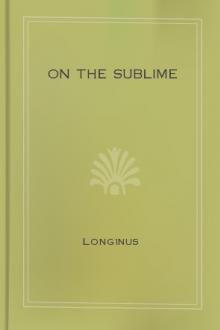On the Sublime by active 1st century Longinus (people reading books .txt) 📖

- Author: active 1st century Longinus
- Performer: -
Book online «On the Sublime by active 1st century Longinus (people reading books .txt) 📖». Author active 1st century Longinus
Therefore it is good for us also, when we are labouring on some subject which demands a lofty and majestic style, to imagine to ourselves how Homer might have expressed this or that, or how Plato or Demosthenes would have clothed it with sublimity, or, in history, Thucydides. For by our fixing an eye of rivalry on those high examples they will become like beacons to guide us, and will perhaps lift up our souls to the fulness of the stature we conceive. 2 And it would be still better should we try to realise this further thought, How would Homer, had he been here, or how would Demosthenes, have listened to what I have written, or how would they have been affected by it? For what higher incentive to exertion could a writer have than to imagine such judges or such an audience of his works, and to give an account of his writings with heroes like these to criticise and look on? 3 Yet more inspiring would be the thought, With what feelings will future ages through all time read these my works? If this should awaken a fear in any writer that he will not be intelligible to his contemporaries it will necessarily follow that the conceptions of his mind will be crude, maimed, and abortive, and lacking that ripe perfection which alone can win the applause of ages to come.
XVThe dignity, grandeur, and energy of a style largely depend on a proper employment of images, a term which I prefer to that usually given.32 The term image in its most general acceptation includes every thought, howsoever presented, which issues in speech. But the term is now generally confined to those cases when he who is speaking, by reason of the rapt and excited state of his feelings, imagines himself to see what he is talking about, and produces a similar illusion in his hearers. 2 Poets and orators both employ images, but with a very different object, as you are well aware. The poetical image is designed to astound; the oratorical image to give perspicuity. Both, however, seek to work on the emotions.
Those maids with bloody face and serpent hair:
See, see, they come, they’re here, they spring upon me!”33
And again—
The poet when he wrote like this saw the Erinyes with his own eyes, and he almost compels his readers to see them too. 3 Euripides found his chief delight in the labour of giving tragic expression to these two passions of madness and love, showing here a real mastery which I cannot think he exhibited elsewhere. Still, he is by no means diffident in venturing on other fields of the imagination. His genius was far from being of the highest order, but by taking pains he often raises himself to a tragic elevation. In his sublimer moments he generally reminds us of Homer’s description of the lion—
And spurs himself to battle.”35
4 Take, for instance, that passage in which Helios, in handing the reins to his son, says—
The hot dry air will let thine axle down:
Toward the seven Pleiades keep thy steadfast way.”
And then—
Then smote the winged coursers’ sides: they bound
Forth on the void and cavernous vault of air.
His father mounts another steed, and rides
With warning voice guiding his son. ‘Drive there!
Turn, turn thy car this way.’”36
May we not say that the spirit of the poet mounts the chariot with his hero, and accompanies the winged steeds in their perilous flight? Were it not so,—had not his imagination soared side by side with them in that celestial passage,—he would never have conceived so vivid an image. Similar is that passage in his “Cassandra,” beginning
5 Aeschylus is especially bold in forming images suited to his heroic themes: as when he says of his “Seven against Thebes”—
Over an iron-bound shield a bull, then dipped
Their fingers in the blood, and all invoked
Ares, Enyo, and death-dealing Flight
In witness of their oaths,”38
and describes how they all mutually pledged themselves without flinching to die. Sometimes, however, his thoughts are unshapen, and as it were rough-hewn and rugged. Not observing this, Euripides, from too blind a rivalry, sometimes falls under the same censure. 6 Aeschylus with a strange violence of language represents the palace of Lycurgus as possessed at the appearance of Dionysus—
Here Euripides, in borrowing the image, softens its extravagance40—
7 Sophocles has also shown himself a great master of the imagination in the scene in which the dying Oedipus prepares himself for burial in the midst of a tempest,42 and where he tells how Achilles appeared to the Greeks over his tomb just as they were putting out to sea on their departure from Troy.43 This last scene has also been delineated by Simonides with a vividness which leaves him inferior to none. But it would be an endless task to cite all possible examples.
8 To return, then,44 in poetry, as I observed, a certain mythical exaggeration is allowable, transcending altogether mere logical credence. But the chief beauties of an oratorical image are its energy and reality. Such digressions become offensive and monstrous when the language is cast in a poetical and fabulous mould, and runs into all sorts of impossibilities. Thus much may be learnt from the great orators of our own day, when they tell us in tragic tones that they see the Furies45—good people, can’t they understand that when Orestes cries out
One of the fiends that haunt me: I feel thine arms
About me cast, to drag me down to hell,”46
these are the hallucinations of a madman?
9 Wherein, then, lies the force of an oratorical image? Doubtless in adding energy and passion in a hundred different ways to a speech; but especially in this, that when it is mingled with the practical, argumentative parts of an oration, it does not merely convince the hearer, but enthralls him. Such is the effect of those words of Demosthenes:47 “Supposing, now, at this moment a cry of alarm were heard outside the assize courts, and the news came that the prison was broken open and the prisoners escaped, is there any man here who is such a trifler that he would not run to the rescue at the top of his speed? But suppose some one came forward with the information that they had been set at liberty by the defendant, what then? Why, he would be lynched on the spot!” 10 Compare also the way in which Hyperides excused himself, when he was proceeded against for bringing in a bill to liberate the slaves after Chaeronea. “This measure,” he said, “was not drawn up by any orator, but by the battle of Chaeronea.” This striking image, being thrown in by the speaker in the midst of his proofs, enables him by one bold stroke to carry all mere logical objection before him. 11 In all such cases our nature is drawn towards that which affects it most powerfully: hence an image lures us away from an argument: judgment is paralysed, matters of fact disappear from view, eclipsed by the superior blaze. Nor is it surprising that we should be thus affected; for when two forces are thus placed in juxtaposition, the stronger must always absorb into itself the weaker.
12 On sublimity of thought, and the manner in which it arises from native greatness of mind, from imitation, and from the employment of images, this brief outline must suffice.48
XVIThe subject which next claims our attention is that of figures of speech. I have already observed that figures, judiciously employed, play an important part in producing sublimity. It would be a tedious, or rather an endless task, to deal with every detail of this subject here; so in order to establish what I have laid down, I will just run over, without further preface, a few of those figures which are most effective in lending grandeur to language.
2 Demosthenes is defending his policy; his natural line of argument would have been: “You did not do wrong, men of Athens, to take upon yourselves the struggle for the liberties of Hellas. Of this you have home proofs. They did not wrong who fought at Marathon, at Salamis, and Plataea.” Instead of this, in a sudden moment of supreme exaltation he bursts out like some inspired prophet with that famous appeal to the mighty dead: “Ye did not, could not have done wrong. I swear it by the men who faced the foe at Marathon!”49 He employs the figure of adjuration, to which I will here give the name of Apostrophe. And





Comments (0)